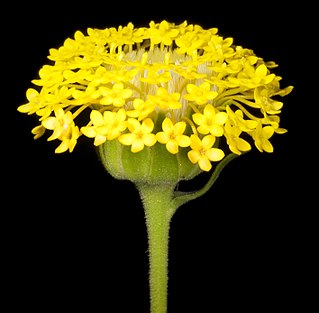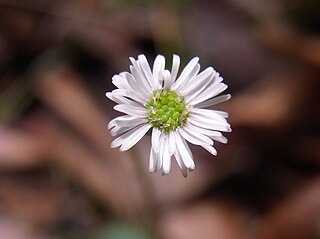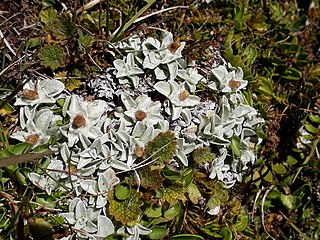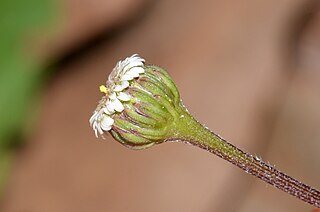
The Colony of New South Wales was a colony of the British Empire from 1788 to 1901, when it became a State of the Commonwealth of Australia. At its greatest extent, the colony of New South Wales included the present-day Australian states of New South Wales, Queensland, Victoria, Tasmania, and South Australia, the Northern Territory as well as New Zealand. The first "responsible" self-government of New South Wales was formed on 6 June 1856 with Sir Stuart Alexander Donaldson appointed by Governor Sir William Denison as its first Colonial Secretary.

Coprosma is a genus of flowering plants in the family Rubiaceae. It is found in New Zealand, Hawaiian Islands, Borneo, Java, New Guinea, islands of the Pacific Ocean to Australia and the Juan Fernández Islands.

Abrotanella is a genus in the family Asteraceae, of 23 species, native to Australia, New Zealand and southern South America.

The states and territories are the second level of government of Australia. The states are administrative divisions that are self-governing polities that are partly sovereign, having ceded some sovereign rights to the federal government. They have their own constitutions, legislatures, executive governments, judiciaries and law enforcement agencies that administer and deliver public policies and programs. Territories can be autonomous and administer local policies and programs much like the states in practice, but are still legally subordinate to the federal government.
The following lists events that happened during 1908 in Australia.

The Australian and New Zealand Association for the Advancement of Science (ANZAAS) is an organisation that was founded in 1888 as the Australasian Association for the Advancement of Science to promote science.

Leucophyta is a plant genus which is endemic to Australia. The genus was first formally described by botanist Robert Brown in 1818.

Callitris rhomboidea, commonly known as the Oyster Bay pine, Tasmanian cypress pine, Port Jackson pine, Illawarra mountain pine, or dune cypress pine, is a species of conifer in the family Cupressaceae. It is native to Australia, occurring in South Australia, Queensland, New South Wales, Victoria and Tasmania. It has become naturalized near Auckland, New Zealand and can be found on the island of Taillefer Rocks in Tasmania.

Gahnia is a genus of sedges native to China, Southeast Asia, New Guinea, Australia, New Zealand and a number of Pacific Islands. The common name is due to the toothed margins. It often forms tussocks.

Podotheca is a genus of flowering plants in the tribe Gnaphalieae within the family Asteraceae. All species are endemic to Western Australia, except for Podotheca angustifolia which occurs across the south of Australia.

Leptinella is a genus of alpine flowering plant in the family Asteraceae, comprising 33 species, distributed in New Guinea, Australia, New Zealand, South Africa, and South America. Many of the species are endemic to New Zealand.

Lagenophora is a genus of flowering plants in the family Asteraceae. Species occur in South-east Asia, Australia, New Zealand, as well as Central and South America.

Amphibromus is a genus of grasses in the family Poaceae. Most are known as swamp wallaby grass. Most are endemic to Australia. One can also be found in New Zealand and there are two species in South America.

Euchiton is a genus of flowering plants in the family Asteraceae. They are native to Australasia and the Pacific. Some have been introduced far outside their native ranges.
Lachnagrostis is a genus of African, Australian, Pacific Island, and South American plants in the grass family. They are often treated as members of genus Agrostis.

Lagenophora gracilis is a small plant in the family Asteraceae, found in eastern Australia, and in tropical Asia. Common names include slender bottle-daisy and slender lagenophora. The habitat is the floor of Eucalyptus forests, often in moist situations.

Argyrotegium is a genus of plants in the family Asteraceae, native to Australia and New Zealand.

The New Zealand cricket team toured Australia in February 1899, playing two first-class matches against state teams and two other matches. It was New Zealand's first overseas tour.

Lagenophora huegelii is a species of flowering plant in the family Asteraceae which is endemic to Western Australia. It was formerly considered to also grow in eastern Australia and Tasmania, though these populations are considered a separate species: Lagenophora gunniana.

Lagenophora gunniana, the coarse bottle-daisy, is a small flowering plant in the family Asteraceae native to the southeastern Australia mainland and Tasmania. The species was first formally named by Joachim Steetz in 1845.
















